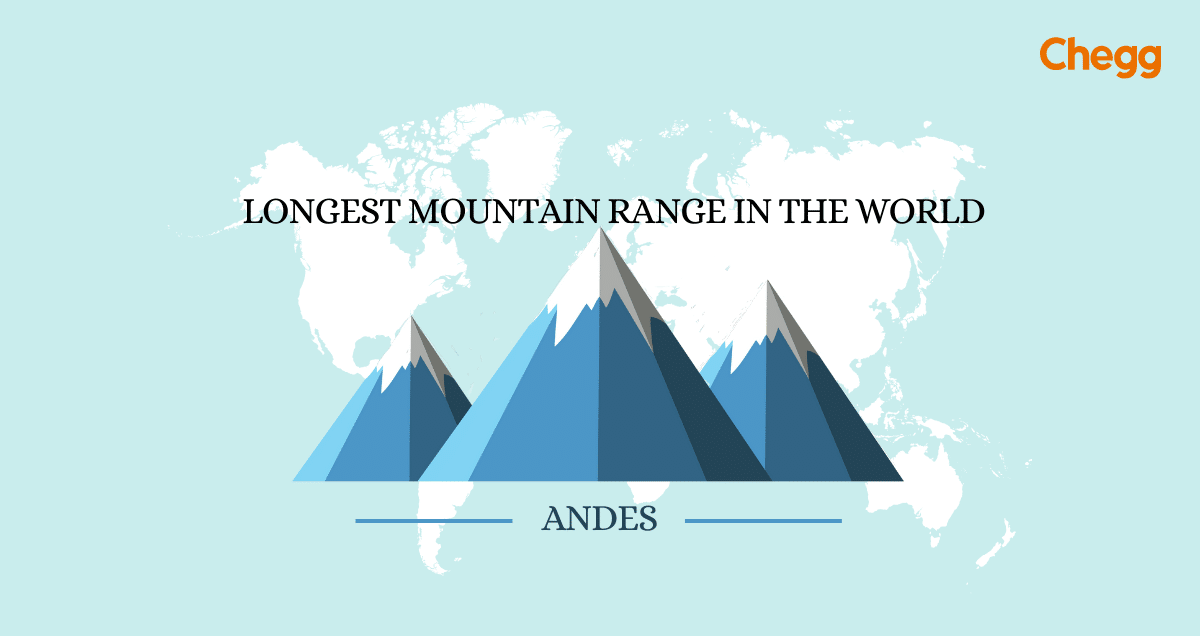
Quick Summary
The Andes is the longest mountain range in the world, stretching for over 7,000 kilometers along South America’s western coast.
This mountain range spans seven countries, including Argentina, Chile, Peru, and Bolivia.
The Andes is not only the longest mountain range but also one of the most important in terms of biodiversity and geological history.
Table of Contents
In the entire course of history, the Longest Mountain Range in the World has always been something people admire. Even though they can be dangerous, people want to climb them because of their beauty. Everyone wishes they could visit the longest mountain range in the world, but even the smaller mountains are a sight to behold. The longest mountain range in the world is the Andes, a colossal chain of mountains that stretches across the western edge of South America. Spanning over 7,000 kilometers (4,300 miles), the Andes mountains run through seven countries in South America, making them not only the longest but also one of the most geographically significant ranges on Earth.
The Andes have been a crucial part of South America’s landscape for millions of years, influencing the climate, culture, and biodiversity of the region. From the towering peaks to the deep valleys, the Andes have a rich history that has shaped the civilizations that lived in its shadow, such as the ancient Incas. In this article, we will explore the Andes mountains, their impressive length, their geological formation, and why they hold the title of the longest mountain range in the world.
The longest mountain range in the world is the Andes, a massive range that stretches for over 7,000 kilometers (4,300 miles) along the western edge of South America. The Andes are one of the most important geological and ecological features of the continent, spanning several countries and offering breathtaking landscapes.
Mountains have a lot of cultural significance to people. This is why people always name them to give them a sense of identity. We have included mountains in every cultural aspect. For example, mythology, religions, metaphors, and more. Even the longest mountain range in the world, such as the Andes, carries deep cultural meaning for the indigenous communities that have lived alongside it for centuries. These majestic ranges not only shape landscapes but also inspire stories, beliefs, and a profound connection to nature.
You may always wonder which is the longest mountain range in the world. And your answer lies in the majestic Andes mountains. It ranges around 7000 Km, it’s also the Longest Mountain Range in the World by Area. Here are some interesting facts about the longest mountain range in the world:
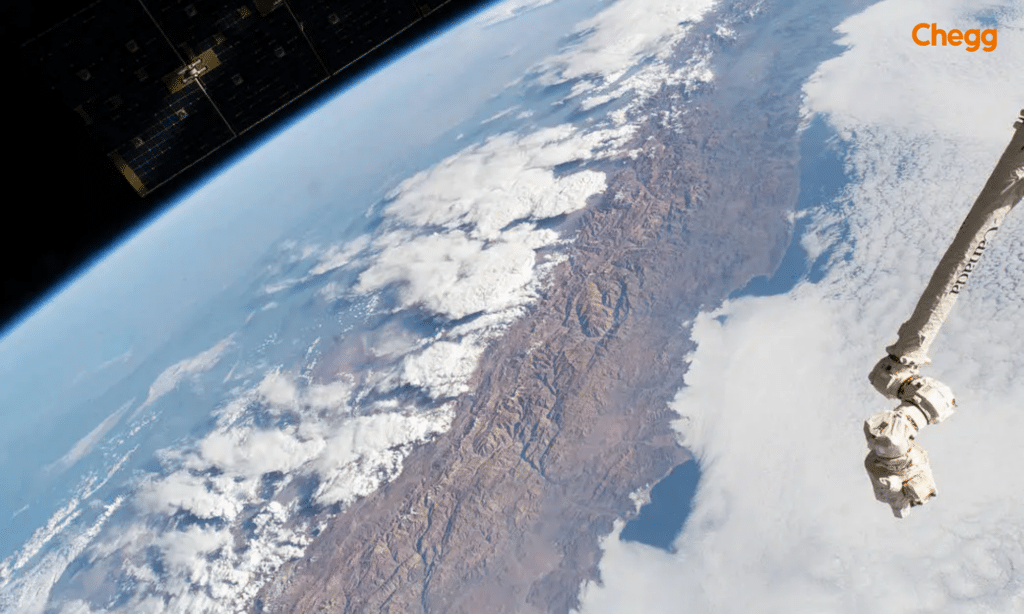
The overall Mid-Atlantic ridge is 80000 km in range while the continuous mountain range is 65000 km in range. They are over 9 times larger than the Andes, which makes them the largest and longest mountain range in the world. However, over 90% is underwater.
A ridge in the middle of the ocean may move slowly or rapidly. Cracks and crumbles form in the slowly spreading ridges, leaving behind hills and valleys. Mid-ocean ridges are spreading rapidly and are now moving more smoothly and easily.
In most cases, mid-ocean ridges move little more than two to four inches every year. Both ridge-push and slab-pull mechanisms contributed to the expansion of the mid-ocean ridges.
The longest mountain range in the world, the Mid-Ocean Ridge, is not just an awe-inspiring geological feature; it also harbors unique ecosystems. It is home to both hydrothermal vent ecosystems and cold seep ecosystems. Some of its ecosystems are completely decoupled from the ecosystems on the surface. This is because they must evolve to use organic matter synthesized by bacteria that reduces hydrogen sulfide. Till now, over 300 endemic species have been discovered in this longest mountain range in the world.
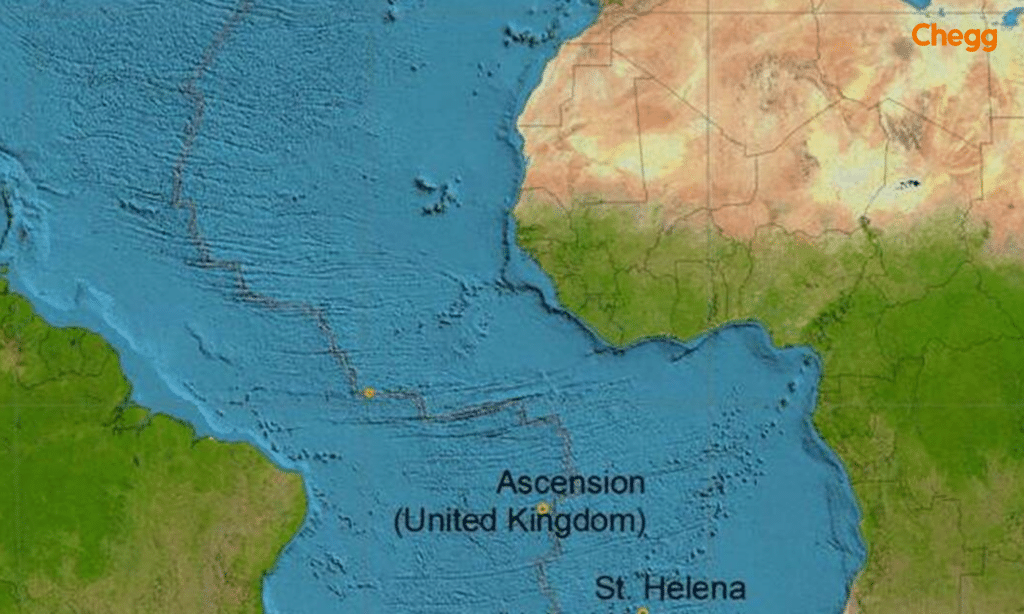
The longest mountain range in the world is not located on land but lies beneath the ocean’s surface. The Mid-Ocean Ridge is the longest mountain range in the world underwater that stretches over 65,000 kilometers (40,000 miles). This submerged giant snakes its way around the globe, much like the seam of a baseball.
The Mid-Ocean Ridge is formed by the movement of the Earth’s tectonic plates. As these plates diverge, magma rises from the mantle to fill the gaps, creating new seafloor and forming mountains and valleys along the seafloor. This process, known as seafloor spreading, is renewing the surface of our planet.
The Mid-Ocean Ridge is not just the longest mountain range on Earth, but it also forms the largest single volcanic feature on the planet. It consists of thousands of individual volcanoes or volcanic ridge segments which periodically erupt. Despite being largely hidden beneath the ocean’s surface, the Mid-Ocean Ridge has a significant impact on our planet. It plays a crucial role in regulating the Earth’s climate and is home to a diverse range of marine life.
Mountain ranges are some of the most impressive natural formations on Earth, stretching across vast distances and often serving as important geographical and cultural landmarks. Here’s a list of the top 10 longest mountain ranges in the world, along with some key details about each.
Some of the most recognizable and breathtaking sights on Earth are mountain ranges. Every kind of adventurer may find their perfect mountain range, from the lofty Himalayas to the wild Andes. Some of the most prominent mountain ranges of the world are listed in the given table:
| Continent | Popular Mountains |
| Africa | Atlas Mountains |
| East African Mountains | |
| Asia | Himalayas |
| Japanese Alps | |
| T’aebaek Mountains | |
| Antarctica | Queen Alexandra Range |
| Tangra Mountains | |
| Royal Society Range | |
| Australia | Australian Alps |
| Snowy Mountains | |
| Southern Alps | |
| Europe | Alps |
| Caucasus | |
| Balkan Mountains | |
| North America | The Appalachian Mountains |
| American Cordillera | |
| Sierra Maestra | |
| South America | The Andes |
| Serra do Mar | |
| Cordillera Huayhuash |
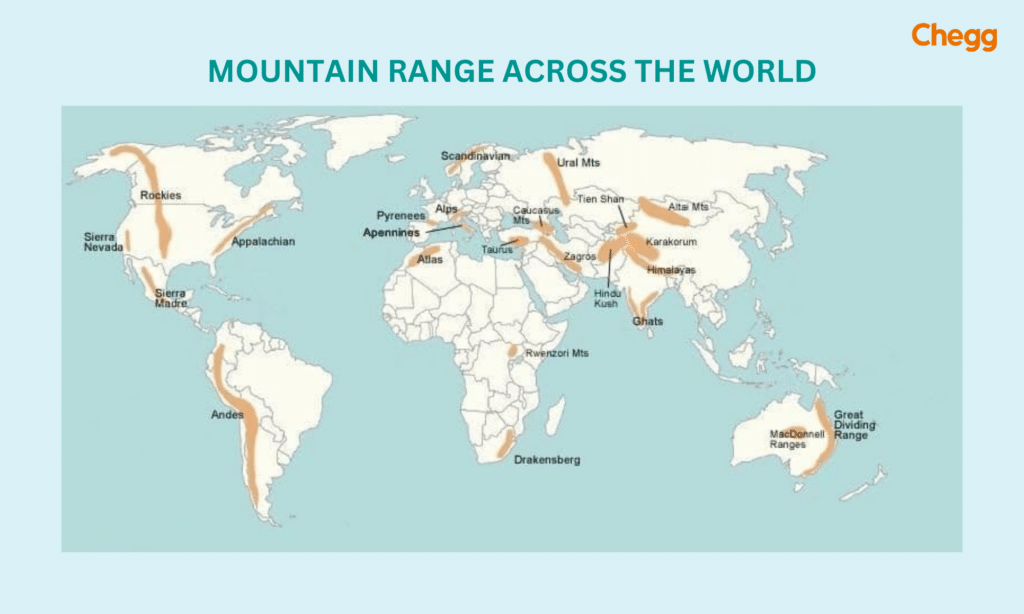
There is a mountain range somewhere that will appeal to your particular set of interests. Mountain ranges have something to offer everyone. Whether you are looking for breathtaking beauty or a difficult hiking route, you can find it on a mountain. Some of the mountains also have different cultures.
For example, the Himalayas tend to have a lot of cultural value. This is because of the Buddhist monasteries and Hindu temples present there. Just like this, every mountain range has its history and significance.
The Barberton Makhonjwa Mountains are the oldest mountain range in the world. Their geological age is 3.5 billion years. While not the longest mountain range in the world, this ancient range holds immense significance due to its age and formation. This mountain range was founded in 1884 after a gold rush was sparked by the discoveries of George Barber and his cousins Fred and Harry Barber. Meteorite impacts probably formed this mountain range.
Those curious about Earth’s past and its natural beauty should make a point of visiting the Barberton Makhonjwa Geotrail. The Barberton Makhonjwa Geotrail is a 38-kilometer trip through geological structures that have existed since the Archaean era.
The ancient rock formations of the Barberton Makhonjwa Mountain Land are well-known, but the region’s history and culture are also highly regarded. An example of this is the town of Barberton, which has become a tourist attraction.
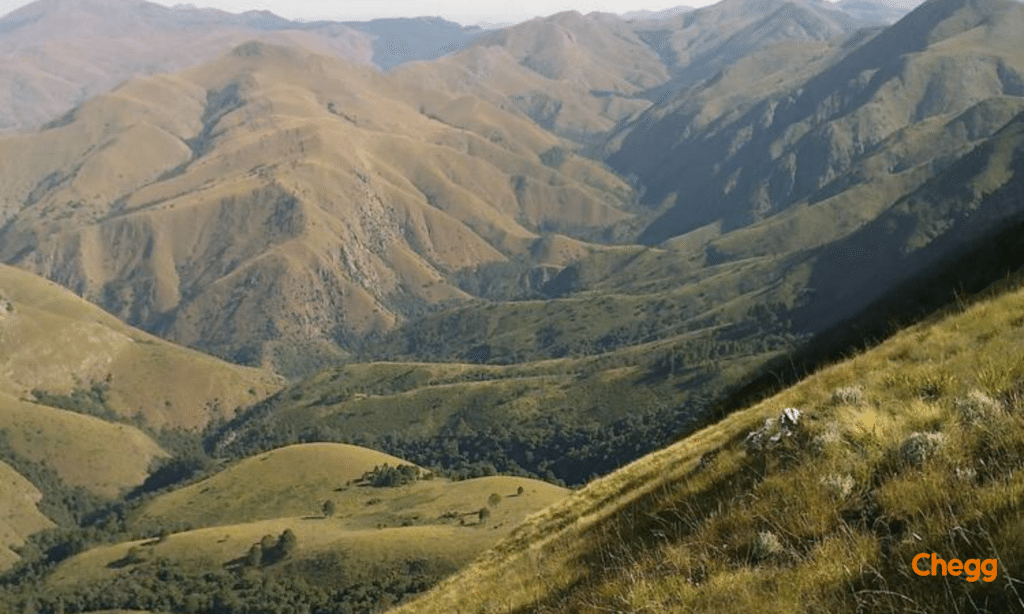
The highest mountain range in the world is Mount Everest. It is positioned between Nepal and China’s Tibet autonomous region.
Throughout history, we have been in awe of mountain ranges and used them for our interests. Some religious and mythological traditions also feature mountains. For example, the Kikuyu people resorted to Mount Kenya during droughts to pray to their god, Ngai, for rain. Chinese communities typically built temples to honor the mountain god.
The linguistic diversity seen in mountain regions is astounding. There are at least seven indigenous communities located in the Italian Alps with their languages. This shows the region’s rich linguistic and cultural variety.
People can have both a positive and negative effect on the mountains. It’s important to reduce the pollution left behind by humans on these mountains as much as possible. Everyone should be careful of the waste they leave behind whenever they visit these areas. The economic benefits from these mountain ranges should also remain in local communities to decrease poverty.
The topic of the world’s longest mountain range is included in the Class 6 curriculum to help students understand the fascinating world of geography and earth science. Here’s why it’s important:
So, studying the Longest Mountain Range in the World helps Class 6 students gain a well-rounded understanding of geography and develop important skills.
The mighty Andes Mountains, stretching across the length of South America, hold a special place in the curriculum – they’re often introduced in Class 10 Geography. But why is the longest mountain range in the world is class 10 included in your studies? Let’s explore the reasons!
Remember, studying the Andes is not just about learning facts. It’s about understanding geography, appreciating our planet’s diversity, and developing valuable skills. For more details, Here is the link for the PDF of the Class 10 Geography Book.
People of all backgrounds appreciate the Longest Mountain Range in the World. Their natural beauty is well-known. But they are also quite useful. The trees in the mountains act as a natural carbon sink and air purifier. Mountains can also act as water towers. They collect water and then release it into nearby waterways.
They have changed and affected our ecosystems over and over again. Also, they tend to have cultural importance in a lot of societies.
Mountains provide the best connection to your spiritual self. If you want a break, they will help you get peace. So, visit a mountain range for a much-needed break. Everyone must explore the Longest Mountain Range in the World at least once in their life!
The Andes is the longest mountain range in the world, extending over 7,000 kilometers and influencing the geography, culture, and biodiversity of South America. From its geological formation to its rich ecosystems and cultural significance, the Andes is a natural wonder that has captivated explorers, scientists, and travelers for centuries. Understanding which is the longest mountain in the world helps us appreciate the complexity of Earth’s geology and the diversity of life that thrives in this remarkable range.
The longest mountain range is the Andes.
The Barberton Makhonjwa Mountains are the oldest mountain range.
Mountains that are connected by high ground form a mountain range.
Mountain ranges are formed when tectonic plates clash with each other.
The Himalayas are the highest mountain range in the world, home to Mount Everest, reaching 8,848.86 meters tall.
The Kunlun Mountains in China are the longest mountain range in Asia, stretching over 3,000 kilometers (1,900 miles).
The Andes is the longest mountain range in the world, approximately 7,000 kilometers, stretching along South America’s western coast.
Also Read:-

Authored by, Amay Mathur | Senior Editor




Amay Mathur is a business news reporter at Chegg.com. He previously worked for PCMag, Business Insider, The Messenger, and ZDNET as a reporter and copyeditor. His areas of coverage encompass tech, business, strategy, finance, and even space. He is a Columbia University graduate.
Editor's Recommendations
Chegg India does not ask for money to offer any opportunity with the company. We request you to be vigilant before sharing your personal and financial information with any third party. Beware of fraudulent activities claiming affiliation with our company and promising monetary rewards or benefits. Chegg India shall not be responsible for any losses resulting from such activities.
Chegg India does not ask for money to offer any opportunity with the company. We request you to be vigilant before sharing your personal and financial information with any third party. Beware of fraudulent activities claiming affiliation with our company and promising monetary rewards or benefits. Chegg India shall not be responsible for any losses resulting from such activities.